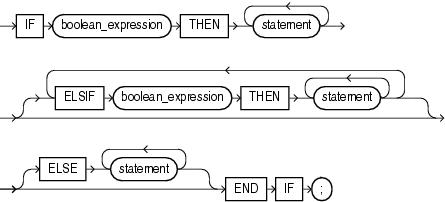| Oracle® Database PL/SQL User's Guide and Reference 10g Release 2 (10.2) Part Number B14261-01 |
|
|
View PDF |
| Oracle® Database PL/SQL User's Guide and Reference 10g Release 2 (10.2) Part Number B14261-01 |
|
|
View PDF |
The IF statement executes or skips a sequence of statements, depending on the value of a Boolean expression. For more information, see "Testing Conditions: IF and CASE Statements".
Syntax
if statement ::=

Keyword and Parameter Description
boolean_expression
An expression that returns the Boolean value TRUE, FALSE, or NULL. Examples are comparisons for equality, greater-than, or less-than. The sequence following the THEN keyword is executed only if the expression returns TRUE.
ELSE
If control reaches this keyword, the sequence of statements that follows it is executed. This occurs when none of the previous conditional tests returned TRUE.
ELSIF
Introduces a Boolean expression that is evaluated if none of the preceding conditions returned TRUE.
THEN
If the expression returns TRUE, the statements after the THEN keyword are executed.
Usage Notes
There are three forms of IF statements: IF-THEN, IF-THEN-ELSE, and IF-THEN-ELSIF. The simplest form of IF statement associates a Boolean expression with a sequence of statements enclosed by the keywords THEN and END IF. The sequence of statements is executed only if the expression returns TRUE. If the expression returns FALSE or NULL, the IF statement does nothing. In either case, control passes to the next statement.
The second form of IF statement adds the keyword ELSE followed by an alternative sequence of statements. The sequence of statements in the ELSE clause is executed only if the Boolean expression returns FALSE or NULL. Thus, the ELSE clause ensures that a sequence of statements is executed.
The third form of IF statement uses the keyword ELSIF to introduce additional Boolean expressions. If the first expression returns FALSE or NULL, the ELSIF clause evaluates another expression. An IF statement can have any number of ELSIF clauses; the final ELSE clause is optional. Boolean expressions are evaluated one by one from top to bottom. If any expression returns TRUE, its associated sequence of statements is executed and control passes to the next statement. If all expressions return FALSE or NULL, the sequence in the ELSE clause is executed.
An IF statement never executes more than one sequence of statements because processing is complete after any sequence of statements is executed. However, the THEN and ELSE clauses can include more IF statements. That is, IF statements can be nested.
Example 13-3 shows an example of the IF-THEN-ELSIF-ELSE statement.
Example 13-3 Using the IF Statement
DECLARE jobid employees.job_id%TYPE; empid employees.employee_id%TYPE := 115; sal_raise NUMBER(3,2); BEGIN SELECT job_id INTO jobid from employees WHERE employee_id = empid; IF jobid = 'PU_CLERK' THEN sal_raise := .09; ELSIF jobid = 'SH_CLERK' THEN sal_raise := .08; ELSIF jobid = 'ST_CLERK' THEN sal_raise := .07; ELSE sal_raise := 0; END IF; END; /
For examples, see the following:
Related Topics